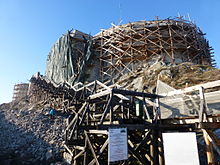Deva Castle
| Deva Castle | ||
|---|---|---|
|
Deva Castle |
||
| Creation time : | 13th Century | |
| Conservation status: | ruin | |
| Geographical location | 45 ° 53 '19 " N , 22 ° 53' 50" E | |
| Height: | 371 m | |
|
|
||
The Deva Castle (also Diemricher Castle , Romanian Cetatea Deva ) is located in the city of Deva ( Diemrich ) in the Hunedoara district in Romania .
location
In the north of the city of Deva, the castle ruins are located on a 371 meter high volcanic cone and can be reached on foot or with a 278 meter long inclined elevator .
history
The castle was first mentioned in 1269 when Stephan V, King of Hungary, mentioned it as the "royal castle Deva" in a privilege given to the Count of Câlnic ( Romanian comitele Chyl din Câlnic ).
In 1307 the Bavarian Duke Otto was imprisoned here in the castle by the Transylvanian voivod Ladislaus. Since 1321 this and its surroundings had been the estate of the Hungarian King Charles I. The royal and princely castle passed into the possession of Johann Hunyadi in the 15th century . In 1579 the Transylvanian Saxon Franz Hertel alias Franz Davidis, who was sentenced to life imprisonment, died here . After the Crusades, the Kuruc 1687-1706 the castle was built by the troops of Emperor Charles VI. occupied and renovated in 1752. An attempt by insurgents of the Horea uprising in November 1784 to take the castle failed. After a visit by Emperor Franz I in 1817, the castle was renovated again. After the castle was partially destroyed in 1849 due to an explosion of powder reserves - and many soldiers also died - it was abandoned and not rebuilt.
The castle ruins are under monument protection. After the castle's state of preservation had deteriorated and some areas such as the inner courtyard of the fortress were no longer accessible, extensive restoration work began in spring 2013 after years of delays and should be completed in December 2014. These restoration measures, worth around 38.5 million Romanian lei (approx. 8.5 million euros), are financed by the European Union , the Romanian government and private donors.
Numerous archaeological finds that point to the Neolithic Age have been made on and around the castle hill .
The European horned viper is native to the castle hill .
See also
Web links
- P. Kovács Klára: The Devan Castle at enciclopediavirtuala.ro, (Romanian)
Individual evidence
- ↑ a b Heinz Heltmann, Gustav Servatius (Ed.): Travel Guide Siebenbürgen. Kraft, Würzburg 1993, ISBN 3-8083-2019-2 .
- ^ Floca Octavian, Ben Bassa: Cetatea Deva (= Monumentele patriei noastre ). Editura Meridiane, Bucharest 1965, p. 14 (Romanian): "sub castro Dewa contra Cumanorum exercitur viriliter dimicavit"
- ^ László Veszprémy: Chronicles in Charters. Historical Narratives (narrationes) in Charters as Substitutes for Chronicles in Hungary . In: Erik Kooper (ed.): The Medieval Chronicle III . 2005, ISBN 90-420-1875-5 , pp. 194 ( limited preview in Google book search): "Magister Pertrus de genere Chak, 1273, In castrum Feketeholm sub castro Deva viriliter dimicavit, quosdam captivando, quosdam perimendo, triumphalem victoriam reportavit;"
- ↑ List of historical monuments of the Romanian Ministry of Culture , updated 2010. ( Memento of the original of June 10, 2012 in the Internet Archive ) Info: The archive link was automatically inserted and not yet checked. Please check the original and archive link according to the instructions and then remove this notice. (PDF; 7.10 MB).
- ^ Institute Of Archeology - Deva , accessed January 15, 2014 (Romanian).
- ↑ Picture with a warning sign of snakes



